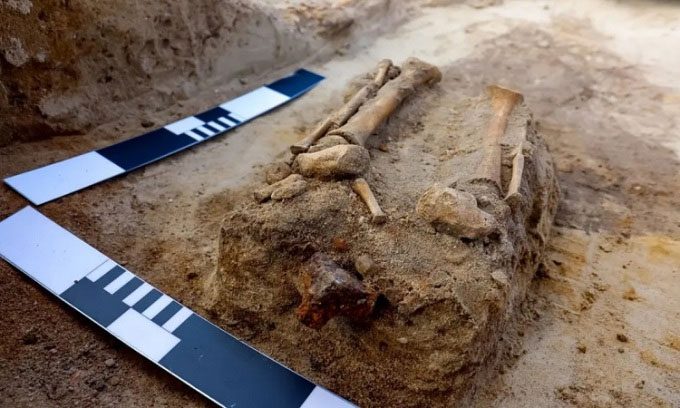The burial of a 5 – 7 year old child suspected of being a “vampire” using a triangular iron clamp to secure it in the grave for 400 years.
Researchers unearthed the skeleton of a child “vampire” buried face down and shackled to the ground, likely to soothe the fears of the villagers and ensure the deceased would not return. The skeleton of the child, approximately 5 – 7 years old, was discovered in an unmarked mass grave in Pień village, near Ostromecko, Poland.
Also at this cemetery, last year, the research team found the remains of a woman “vampire” who was shackled at the thumb and had a sickle placed across her neck to prevent the deceased from rising from the grave.

Child’s skeleton buried with iron clamp in the grave. (Photo: Dariusz Poliński)
Professor Dariusz Poliński from Nicolaus Copernicus University, who oversaw both excavations, stated that the two graves were located two meters apart in the cemetery. He and his colleagues believe that this is a makeshift burial ground for “the outcasts”, who were not buried in Christian cemeteries for various reasons.
Poliński’s team has excavated approximately 100 graves in the cemetery, many of which reveal unusual burial practices, including measures to prevent vampires, such as triangular clamps placed on the feet to secure the deceased to the ground. They speculate that there are several reasons why a person might be buried in such a cemetery. The individual may have exhibited strange behavior while alive, causing fear among those around them, or they could have died from a disease that made their appearance unusual. It could also be that the deceased passed away suddenly under mysterious circumstances.
Villagers in the 17th century tended to fear children buried without a baptism ceremony or those who drowned. According to Poliński, the archaeological team also found numerous bones near the child’s grave along with the remains of a woman who was approximately six months pregnant.
Matteo Borrini, a lecturer in anthropology at John Moore University in Liverpool, noted that the practice of burying vampires was common in Europe from the 14th century. People of that time believed that vampires would hunt and kill immediate family members first, followed by neighbors and others in the village.


















































